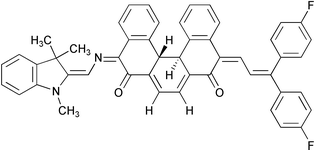Investigations by NMR spectroscopy of a polyphotochromic system involving two entities, spirooxazine and naphthopyran, linked by a Z-ethenic bridge
Abstract
The biphotochromic molecule, made up of spirooxazine and

* Corresponding authors
a
UMR CNRS 8009, Laboratoire de Physique et d'Application RMN, Faculté de Pharmacie, BP83, F-59006 Lille Cedex, France
E-mail:
Gaston.Vermeersch@phare.univ-lille2.fr
b UMR CNRS 6114, LCMOM, Faculté des Sciences de Luminy, F-13288 Marseille Cedex 9, France
The biphotochromic molecule, made up of spirooxazine and

 Please wait while we load your content...
Something went wrong. Try again?
Please wait while we load your content...
Something went wrong. Try again?
J. Berthet, S. Delbaere, D. Levi, P. Brun, R. Guglielmetti and G. Vermeersch, J. Chem. Soc., Perkin Trans. 2, 2002, 2118 DOI: 10.1039/B206574F
To request permission to reproduce material from this article, please go to the Copyright Clearance Center request page.
If you are an author contributing to an RSC publication, you do not need to request permission provided correct acknowledgement is given.
If you are the author of this article, you do not need to request permission to reproduce figures and diagrams provided correct acknowledgement is given. If you want to reproduce the whole article in a third-party publication (excluding your thesis/dissertation for which permission is not required) please go to the Copyright Clearance Center request page.
Read more about how to correctly acknowledge RSC content.
 Fetching data from CrossRef.
Fetching data from CrossRef.
This may take some time to load.
Loading related content
